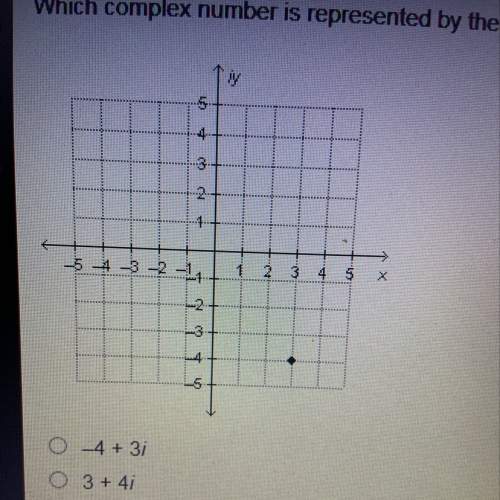
Mathematics, 04.05.2021 17:20 ash3246
Particle in a Cylinder
A particle exists in three dimensions and is trapped inside a solid S. The cross section of the cylinder C on the xy plane is the region bounded between r = cos(2θ) and r = sin(2θ) in the first quadrant. All the points in the solid S exists inside the cylinder C bounded between the planes z = −y and z = y.
Before we can get into the particle dynamics, we need to introduce the notion of "inner product." You are already familiar with the dot product of two vectors. Dot products give a sense of how much the two vectors are aligned with each other. In layman’s terms, a function can be thought of as a vector with infinite components. Lets put this in perspective, a 3d vector ~a = axˆi+ayˆj +azkˆ has three components ax, ay, and az. Now, lets consider a function f defined by the map f : x 7→ 7x, where x ∈ [−3,2] ; then the "xth" component of the "vector" f is just f (x), or equivalently 7x. Since x can take the value of any real number between −3 and 2 and that there are infinite real numbers between any two numbers, then it follows that the "vector" f has infinite components. In the case of the dot product, we have to take a summation, and in the case of an inner product, we have to take an integral. The definition of the inner product of two functions g and h
(denoted by hg|hi) over a volume S is defined as
(7)
where g (x, y,z)∗ is the complex conjugation of g (x, y,z).
The probability of finding the particle anywhere outside the solid S is 0 and the probability of finding the particle inside the solid S is non zero. The probability density function (PDF in short) which describes this fact mathematically is
PDF = ψ (x, y,z)∗ ψ (x, y,z), (8)
where ψ is
lies within S
0, ,
where A is a positive constant.
(a) Write down the value of hψ|ψi, explain your reasoning in one sentence. (Your answer should be a number, do not evaluate any integral)
[2]
(b) Now write down the integral(s) with the limits in order to evaluate hψ|ψi using equation (7) and explain why cylindrical coordinates will be a good choice to evaluate the integral (Do not evaluate the integral yet)
[10]
(c) Find the volume element in cylindrical coordinates with the help of the Jacobian determinant
[4]
(d) Find the value of A
[10] When dealing with probabilities, we are often interested in calculating the expectation values of certain quantities. Before we move into that, we need to understand what are operators. Operators act on functions and change them. Lets define the following operator, rˆ which acts on a function ψ and produces r (the number which represents axial distance) times ψ. Mathematically,
rψˆ = rψ (9)
To find the perpendicular distance from the z axis (the axial distance r) that we expect the particle to be found at, we need to find the expectation value of r. Given that, the expectation value of r is the inner product hψ|rψˆ i
(e) Evaluate hψ|rψˆ i with the help of equation (9)
[10]
An operator can act on a function twice; we represent this by a square on the operator. Numbers can be taken outside of the operator when it acts on a function (i. e. if Aˆ is an operator acting on a function kf, where k is a number, then Aˆ(kf) = kAfˆ )
(f) Evaluate rˆ2ψ using equation (9)
[2]
(g) Given that, the expectation value of r2 is the inner product hψ|rˆ2ψi, find the expectation value of r2 [8]
(h) We can finally calculate the uncertainty in the axial distance using the relation
,
where σr is the uncertainty in r.
Find the uncertainty in the axial distance of the particle’s location.

Answers: 3


Other questions on the subject: Mathematics

Mathematics, 21.06.2019 15:00, arias333
Solve the word problem. the table shows the low outside temperatures for monday, tuesday, and wednesday. by how many degrees did the low temperature increase from monday to tuesday? this function table shows the outside temperature for a given a. 21.1⁰ b. 8.6⁰ c. 4.9⁰ d. 3.9⁰(the picture is the graph the the question is talking about.)
Answers: 1

Mathematics, 21.06.2019 16:30, jimyyyy
Which composition of similarity transformations maps polygon abcd to polygon a'b'c'd'? a dilation with a scale factor less than 1 and then a reflection a dilation with a scale factor less than 1 and then a translation a dilation with a scale factor greater than 1 and then a reflection a dilation with a scale factor greater than 1 and then a translation
Answers: 3

Mathematics, 21.06.2019 20:30, jnelso5437
How do you determine if an ordered pair is a solution to a given equation?
Answers: 1
You know the right answer?
Particle in a Cylinder
A particle exists in three dimensions and is trapped inside a solid S. The...
Questions in other subjects:


Spanish, 22.02.2021 17:10



English, 22.02.2021 17:10

German, 22.02.2021 17:10




Chemistry, 22.02.2021 17:10




